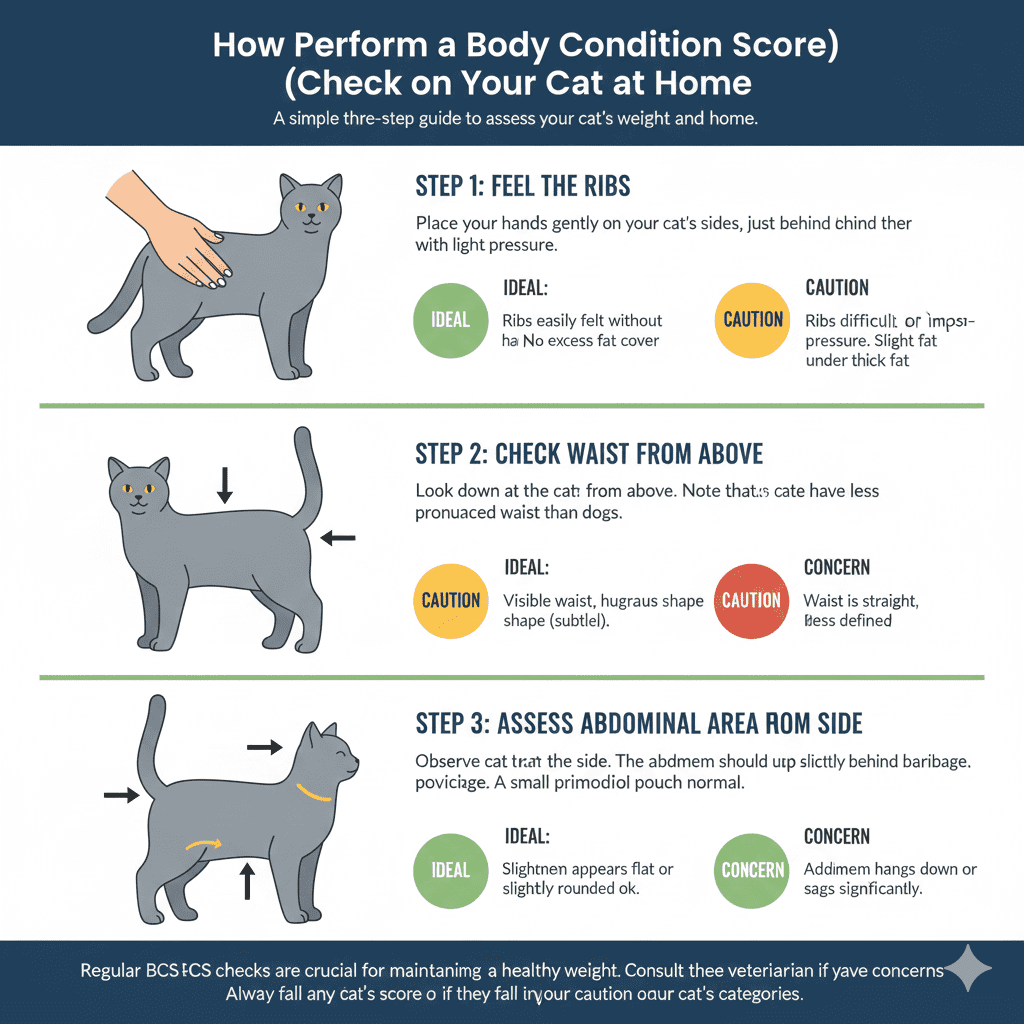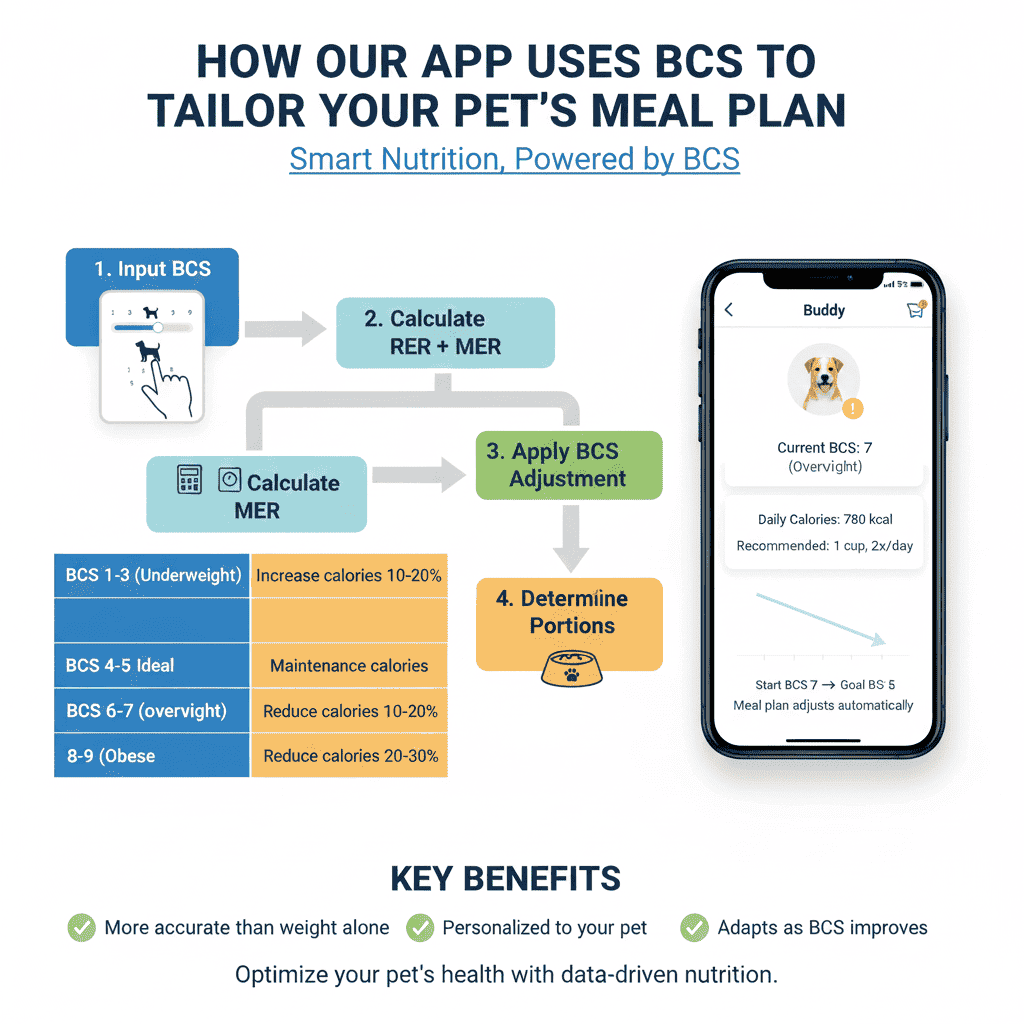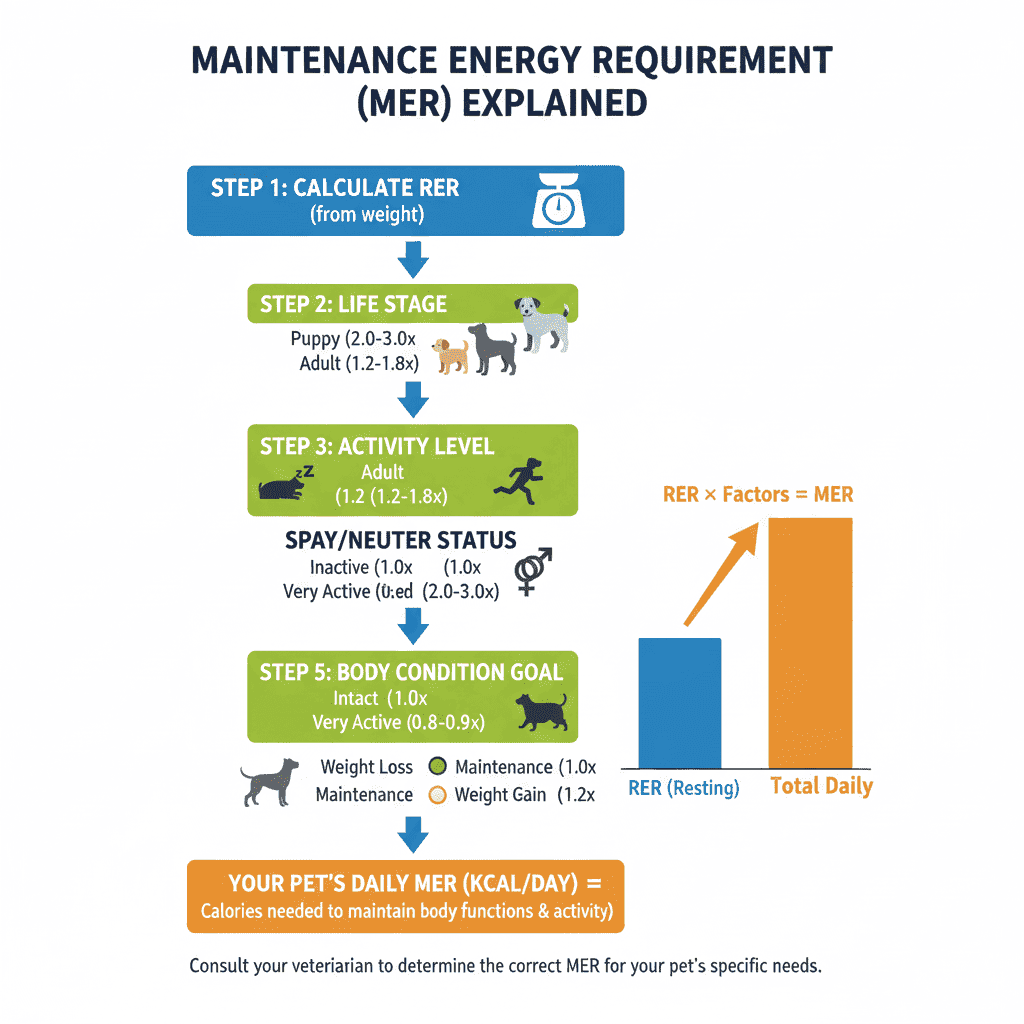Cats are masters of disguise—and that includes hiding their weight issues. With their fluffy coats and natural grace, it can be surprisingly difficult to tell if your cat is at their ideal weight, carrying a few extra pounds, or dangerously obese.
This is why Body Condition Score (BCS) is so valuable. It's the same method veterinarians use to assess your cat's body fat and muscle mass, giving you a clear picture of whether they're too thin, just right, or carrying excess weight.
The best part? You can learn to perform this assessment at home. With a little practice, you'll be able to monitor your cat's body condition between veterinary visits, catch weight issues early (especially the common problem of feline obesity), and make informed decisions about their diet.
Why BCS Matters for Cats
Cats face unique challenges when it comes to weight management:
- Indoor lifestyle: Many cats are less active than their wild ancestors
- Free-feeding: Leaving food out all day can lead to overeating
- Subtle weight gain: Cats can gain weight gradually, making it hard to notice
- Health risks: Obesity in cats increases the risk of diabetes, arthritis, and urinary problems
BCS helps you catch these issues before they become serious health problems.
What You'll Need
- Your cat (standing or sitting calmly)
- Your hands (for feeling ribs and body shape)
- Good lighting
- About 3-5 minutes
- A quiet space where your cat feels comfortable
Tip: Some cats are more cooperative when they're relaxed or sleepy. Choose a time when your cat is calm.

Step-by-Step: The Three-Point Check
The BCS assessment for cats focuses on three key areas: the ribs, the waist, and the abdominal area. Here's how to evaluate each:
Step 1: Feel the Ribs
Position: Stand or sit beside your cat. Gently place your hands on their ribcage.
What to do:
- Place your fingertips on the ribcage, just behind the front legs
- Apply light pressure (similar to feeling the back of your hand)
- Gently run your hands along the ribcage from front to back
- Feel both sides of the ribcage
What you're feeling for:
Ideal (BCS 4-5):
- Ribs are easily felt with light pressure
- You can feel individual ribs
- There's a thin layer of fat covering (like a light blanket)
- Ribs are not visible, but you can feel them clearly
- Smooth, even coverage
Too Thin (BCS 1-3):
- Ribs are very prominent and easily visible
- Little to no fat covering
- You can see individual ribs without touching
- Spine and hip bones are also very prominent
- Feels bony and angular
Overweight (BCS 6-7):
- Ribs are difficult to feel, requiring firm pressure
- Thick layer of fat covering the ribs
- You cannot count individual ribs easily
- Feels like pressing into a soft, padded surface
- May feel like a "pillow" over the ribs
Obese (BCS 8-9):
- Ribs cannot be felt, even with firm pressure
- Very thick fat layer
- Ribcage feels like a solid, heavily padded surface
- Fat deposits may be visible or felt on the back and sides
- No definition of ribs at all
Step 2: Check the Waist (View from Above)
Position: Stand or look directly above your cat, viewing their back from above.
What to look for:
- Find the area just behind the ribs (where the "waist" would be)
- Look at the overall body shape from above
- Compare the width at the ribs to the width at the waist
What you're looking for:
Ideal (BCS 4-5):
- Slight, visible waistline behind the ribs
- Body has a subtle hourglass or "pear" shape when viewed from above
- The waist is slightly narrower than the ribcage
- Smooth, gentle curve inward
Too Thin (BCS 1-3):
- Exaggerated, severe waistline
- Extreme hourglass shape
- Waist is much narrower than the ribcage
- May appear "pinched in" or concave
- Body looks like a figure-8
Overweight (BCS 6-7):
- Waistline is barely visible or absent
- Body appears straight or slightly oval from above
- Little to no narrowing behind the ribs
- May be the same width or wider at the waist than at the ribs
- Back appears broad
Obese (BCS 8-9):
- No waistline visible at all
- Body is round or oval from above
- Significantly wider at the waist than at the ribs
- Back appears very broad and flat
- May look like a "football" shape
Step 3: Assess the Abdominal Area (View from the Side)
Position: Stand or sit beside your cat and view them from the side at eye level.
What to observe:
- Look at the area between the ribcage and the hind legs
- Observe the curve and position of the belly
- Check for the "primordial pouch" (a normal feature in cats)
Important note about the primordial pouch: Many cats have a loose flap of skin and fat on their lower abdomen called the "primordial pouch" or "spay sway." This is normal and not necessarily a sign of obesity. Focus on the area just behind the ribcage, not the lower belly pouch.
What you're looking for:
Ideal (BCS 4-5):
- Slight abdominal tuck visible
- Belly curves slightly upward from the ribcage toward the hips
- The area just behind the ribs is higher than the lower belly
- Smooth, gentle upward curve
- Primordial pouch may be present but not excessive
Too Thin (BCS 1-3):
- Extreme abdominal tuck
- Belly is severely tucked up
- Very pronounced upward curve
- No primordial pouch visible
- May appear "tucked up like a greyhound"
Overweight (BCS 6-7):
- Reduced or absent abdominal tuck
- Belly hangs down or is straight
- Little to no upward curve behind the ribs
- Primordial pouch may be more pronounced
- Belly may sag
Obese (BCS 8-9):
- No abdominal tuck at all
- Belly sags downward significantly
- May hang lower than the bottom of the ribcage
- Obvious "pot belly" appearance
- Primordial pouch is very large and sags
- Belly may swing when the cat walks
Putting It All Together: Determining Your Cat's BCS
After checking all three areas, combine your findings:
BCS 1-3: Underweight
- Ribs, spine, and hip bones easily visible
- Extreme waist and abdominal tuck
- No body fat can be felt
- Action: Consult your veterinarian immediately. Your cat may have underlying health issues, dental problems, or difficulty eating.
BCS 4-5: Ideal Weight (Perfect!)
- Ribs easily felt with light pressure (not visible)
- Slight waistline when viewed from above
- Slight abdominal tuck from the side
- Action: Maintain this condition! Your cat is at their ideal body composition.
BCS 6-7: Overweight
- Ribs difficult to feel, requiring firm pressure
- Waistline barely visible or absent
- Reduced or absent abdominal tuck
- Action: Begin a weight loss program. Reduce calories by 10-20% and encourage more activity through play.
BCS 8-9: Obese
- Ribs cannot be felt, even with firm pressure
- No waistline visible
- No abdominal tuck; belly sags
- Action: Immediate veterinary consultation required. Your cat needs a structured weight loss plan to prevent serious health issues.
Special Considerations for Cats
Long-Haired Cats
For cats with thick, fluffy coats (like Persians, Maine Coons, or Ragdolls):
- Rely heavily on touch - the coat can completely hide body shape
- Feel for ribs and body contours with your hands
- The waist and tuck may be completely invisible visually
- Tactile assessment is essential
- Consider checking during or after grooming
Short-Haired Cats
For cats with short coats (like Siamese, Abyssinians, or American Shorthairs):
- Both visual and tactile assessment work well
- You may be able to see ribs if the cat is underweight
- Body contours are more visible
- Still use touch to confirm what you see
The Primordial Pouch
Many cats have a loose flap of skin on their lower abdomen. This is:
- Normal - not necessarily a sign of obesity
- More common in spayed/neutered cats
- Can be more pronounced in some breeds
- Focus on the area behind the ribs, not the lower belly pouch
- If the entire belly sags and the cat is round, that's obesity, not just the pouch
Indoor vs. Outdoor Cats
- Indoor cats are more prone to obesity due to less activity
- Outdoor cats may be more active but can still become overweight
- Assessment method is the same for both
Senior Cats
Older cats may have:
- Reduced muscle mass (sarcopenia)
- Different body composition
- Health conditions affecting weight
- Reduced mobility
BCS helps distinguish between healthy aging and concerning weight changes.
Common Mistakes to Avoid
-
Checking right after a meal: Your cat's belly will be full. Check when their stomach is empty.
-
Confusing the primordial pouch with obesity: The lower belly pouch is normal. Focus on the area behind the ribs.
-
Not using touch: For long-haired cats especially, you must feel, not just look.
-
Only checking from one angle: You need to check from above (waist) and from the side (abdominal area).
-
Comparing to other cats: Each cat has their own ideal body condition. Don't compare your cat to others.
-
Thinking "a little extra is cute": Even a few extra pounds can significantly impact a cat's health.
-
Not reassessing regularly: Cats can gain weight gradually. Check monthly.
When to Check Your Cat's BCS
Regular monitoring:
- Monthly if your cat is on a weight management program
- Every 3 months if your cat is at ideal weight
- Weekly during active weight loss or gain programs
Special circumstances:
- After spaying or neutering (metabolism changes)
- After illness or surgery
- When transitioning from outdoor to indoor lifestyle
- After diet changes
- If you notice changes in activity level
- During seasonal changes (some cats are less active in winter)
What to Do with Your Results
If Your Cat is Ideal Weight (BCS 4-5)
Excellent! Your cat is at their ideal body condition. To maintain this:
- Continue with current feeding amounts
- Maintain regular play and exercise
- Reassess monthly to catch any changes early
- Adjust portions if activity level changes
If Your Cat is Overweight (BCS 6-7)
Time for action:
- Consult your veterinarian to rule out medical causes (like hypothyroidism)
- Reduce calories by 10-20% from current intake
- Encourage activity through interactive play (feather wands, laser pointers, puzzle toys)
- Consider meal feeding instead of free-feeding
- Reassess monthly to track progress
- Use a meal planner to calculate precise portions
If Your Cat is Obese (BCS 8-9)
Immediate action required:
- Schedule a veterinary visit - obesity in cats is linked to diabetes, arthritis, and urinary problems
- Work with your vet to create a structured weight loss plan
- Reduce calories by 20-30% (under veterinary supervision - rapid weight loss can be dangerous for cats)
- Increase activity gradually through play
- Stop free-feeding - switch to measured meals
- Monitor progress weekly initially
- Be patient - healthy weight loss for cats should be gradual (about 1-2% of body weight per month)
If Your Cat is Underweight (BCS 1-3)
Veterinary consultation needed:
- See your veterinarian immediately - underweight can indicate serious health issues
- Rule out medical causes (dental problems, parasites, hyperthyroidism, kidney disease, cancer)
- Check for eating difficulties - cats may stop eating due to stress, illness, or dental pain
- Increase calories gradually under veterinary guidance
- Consider higher-calorie foods or supplements
- Monitor weekly until reaching ideal weight
Using BCS with Your Meal Planning
At PetMealPlanner, we use your cat's Body Condition Score to create personalized meal plans:
- Input your cat's BCS when setting up their profile
- Our system calculates the appropriate calorie target based on BCS
- Meal plans adjust automatically as your cat's BCS improves
- Track progress by updating BCS monthly
The more accurate your BCS assessment, the more precise your meal plan will be.
The Bottom Line
Learning to perform a Body Condition Score check at home is one of the most valuable skills you can develop as a cat owner. It takes just a few minutes but provides crucial information about your cat's health.
With over 60% of cats in the United States being overweight or obese, regular BCS checks can help you catch weight issues early and prevent serious health problems down the road.
Remember: Practice makes perfect. Your first assessment might feel uncertain, but with regular practice, you'll become more confident. And always discuss your findings with your veterinarian—they can confirm your assessment and help you create a plan to achieve or maintain your cat's ideal body condition.
Ready to create a personalized meal plan based on your cat's body condition? Use our pet meal planner to get started, and don't forget to share your BCS findings with your veterinarian at your next visit.
For more information on Body Condition Scoring, see our comprehensive guide: Beyond the Scale: How to Use Body Condition Score (BCS).


